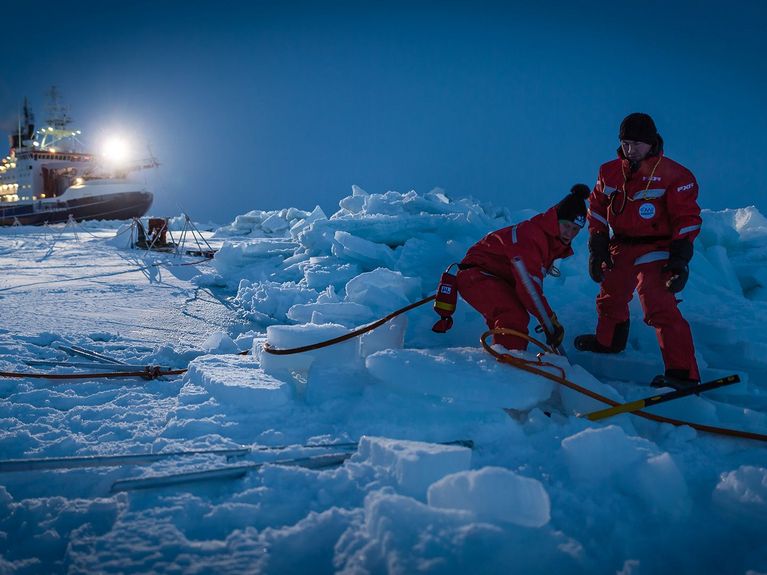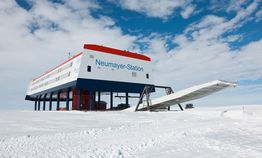
Story #03
How the MOSAiC Expedition Is Helping Us Understand the Arctic
Arctic sea ice is disappearing at an alarming rate – with consequences for the entire planet. Accordingly, on the most extensive Arctic expedition in history, researchers on board the Polarstern investigated how the atmosphere, ice and ocean interact with our environment. Their findings are now helping improve global climate models.
The Arctic is particularly hard hit by anthropogenic climate warming: the ice there is rapidly disappearing. To better understand the region’s climatic processes, we need to gather data there year-round. Yet penetrating the Central Arctic in winter is no mean feat.
Accordingly, in the fall of 2019 the research icebreaker Polarstern allowed herself to become frozen to an ice floe and subsequently drifted through the Arctic Ocean for an entire year. 442 experts took part in the expedition – the most extensive in the history of Arctic research. Today, an entire generation can draw on this unprecedented treasure trove of data from the Arctic.
This tremendous scientific success was made possible by the efforts of numerous Helmholtz researchers, and roughly a decade would pass between the initial concept and commencement of the MOSAiC expedition: core research questions had to be defined, measurements had to be prepared – and, on an expedition of this scale, logistics were a major challenge.
In this regard, the Alfred Wegener Institute (AWI) took hold of the reins: the Helmholtz Centre for Polar and Marine Research coordinated the expedition, in which not only the Polarstern (as the “Central Observatory”) but also six other vessels, various aircraft, and 80 institutions from 20 countries took part. The German Aerospace Center (DLR) supplied ultra-high-resolution radar images of the Arctic, which could then be analyzed together with in-situ data gathered in parallel. Experts from GEOMAR Helmholtz Centre for Ocean Research in Kiel and from GFZ German Research Centre for Geosciences in Potsdam were on the teams tasked with investigating biogeochemical cycles.
MOSAiC - ein Überblick (DE)
All around the ship, a research camp was set up on the ice, allowing observational data to be gathered on and from the Arctic atmosphere, sea ice and snow cover, and from the ocean below. In this way, the MOSAiC team had the opportunity to take a closer look at the epicenter of climate change than ever before – and for the course of an entire year – , making major strides in our grasp of Earth’s climate system and how it is changing.
Today, the data they gathered is available to the public: more than 200 scientific publications have already been released, including a number of pioneering studies. For example, an analysis of meteorological data, together with model-based calculations, shows that ozone depletion in the Arctic polar vortex could further intensify by the end of this century unless we can rapidly and systematically reduce global greenhouse-gas emissions.
During the expedition, 20 storms lashed at the floe, transporting warm air masses to the Central Arctic. The resulting cloud cover produced significant shifts in all components of the surface energy balance, impacting the temperature, growth and melting of sea ice.
In addition, the experts proved that, thanks to naturally occurring Arctic microalgae, photosynthesis was possible even in extremely low-light conditions and therefore at much greater depths than previously assumed.
In the summer of 2025, the Polarstern will once again explore the sea ice of the Central Arctic, using the MOSAiC data as the basis for comparative studies.
Helmholtz believes in providing reliable, essential climate data for society at large – and will continue this mission in the future: the AWI has already commissioned the construction of a successor to the 40-plus-year-old Polarstern; the new flagship of German polar research is slated to commence operations in 2030.
Picture: AWI/Stefan Hendricks
Participating centers
Scientists at the Alfred Wegener Institute, Helmholtz Centre for Polar and Marine Research (AWI) are researching the poles, seas and climate. They aim to unravel the changes taking place in the global environment and System Earth which are partly natural and partly caused by human action.
